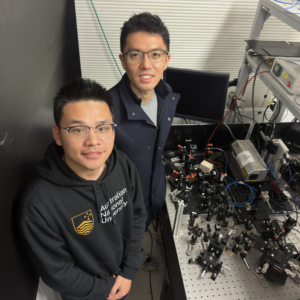A new breakthrough in quantum light sources could make hacking a thing of the past.
31 Aug, 2023
Physicists working in the new field of meta-optics have made a breakthrough in the generation of polarization-entangled photon pairs that could allow quantum key distribution, a highly secure form of cryptography and quantum communication, to be integrated into handheld devices for widespread use in day-to-day communication.
Quantum key distribution uses entangled photon pairs—two photons whose properties are inextricably linked regardless of the distance separating them—as encryption keys. These encryption keys are unbreakable, thanks to the laws of quantum mechanics, rendering it impossible for hackers to intercept information sent.
The problem with current technology that produces entangled photon pairs is that the emitters are created with unstructured bulky, non-linear crystals and can only operate at certain temperatures, requiring comparatively large thermal control devices such as ovens to function. This prevents the technology from being deployed widely, as its hefty size, weight and power requirements limit its applications.
Researchers from TMOS, the ARC Centre of Excellence for Transformative Meta-Optical Systems, have developed an entangled photon emitter using a nonlinear metasurface—a nanometer-thin structured grating that increases the brightness of photon pairs with a specific polarization. Due to its nanometer-scale thickness, the impact of environmental heating and cooling is significantly less than the impact on bulky crystals. Therefore, this new technology is not as sensitive to outside conditions and can operate at all room temperatures.
In quantum cryptography and communications, information is encoded in the amplitude and phase of a photon pair’s entanglement. The device created by TMOS researchers can effectively control all of these. Unlike current technology, it can do so in a way that is easily tuneable—meaning that the end users are able to easily produce multiple polarization states without the need for complex experimental set ups by combining three silicone dioxide metagratings on a single lithium niobite film of only 300 nanometers. Photon entanglement requires multiple simultaneous polarization states. The different gratings on this device generate these different polarizations.

Co-lead author Jinyong Ma says, “Unstructured crystals can only generate photon pairs with a fixed polarization. Our approach, published in Nanoletters last week, overcomes this limitation. This opens the door to the miniaturization of various reconfigurable quantum devices for free-space quantum communication and quantum information processing.”
Co-lead author Jihua Zhang says, “In a previous work, we demonstrated a miniaturized metasurface photon-pair source with spatial entanglement. This new work further released the potential of meta-optics in engineering quantum states and realizing entangled photon pairs in the polarization degree of freedom, which plays a more important role in quantum communications and information.”
Quantum cryptography is of particular interest to researchers because it offers potential protection from hacking as classical communication systems become increasingly vulnerable to attack. In addition, quantum key distribution can be designed to be resistant to various forms of interference and jamming that can interrupt classical communication systems, which is specifically appealing for industries where reliable communication is crucial.
TMOS Chief Investigator Andrey Sukhorukov says, “Meta-optics is crucial for miniaturization of devices, which will facilitate forms of communication not yet imaginable. The next stage for our research is to collaborate with other TMOS teams to effectively measure photon entanglement with metasurfaces.”
For more information about this research, please contact connect@tmos.org.au
Polarization Engineering of Entangled Photons from a Lithium Niobate Nonlinear Metasurface
Jinyong Ma*, Jihua Zhang, Yuxin Jiang, Tongmiao Fan, Matthew Parry, Dragomir N. Neshev, and Andrey A. Sukhorukov
Complex polarization states of photon pairs are indispensable in various quantum technologies. Conventional methods for preparing desired two-photon polarization states are realized through bulky nonlinear crystals, which can restrict the versatility and tunability of the generated quantum states due to the fixed crystal nonlinear susceptibility. Here we present a solution using a nonlinear metasurface incorporating multiplexed silica metagratings on a lithium niobate film of 300 nm thickness. We fabricate two orthogonal metagratings on a single substrate with an identical resonant wavelength, thereby enabling the spectral indistinguishability of the emitted photons, and we demonstrate in experiments that the two-photon polarization states can be shaped by the metagrating orientation. Leveraging this essential property, we formulate a theoretical approach for generating arbitrary polarization-entangled qutrit states by combining three metagratings on a single metasurface, allowing the encoding of the desired quantum states or information. Our findings enable miniaturized optically controlled quantum devices by using ultrathin metasurfaces as polarization-entangled photon sources.